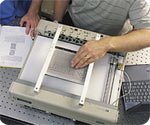Tactile Video Displays

The National Institute of Standards and Technology has licensed a technology for the commercialization of a tactile graphic display device. The device promises users who are blind the ability to feel images from any number of sources on a refreshable braille display. The technology has been in development for awhile, but commercialization is a significant step forward.
From the press release:
ELIA Life Technology Inc. of New York, N.Y., licensed for commercialization both the tactile graphic display device and fingertip graphic reader developed by NIST researchers. The former, first introduced as a prototype in 2002, allows a person to feel a succession of images on a reusable surface by raising some 3,600 small pins (actuator points) into a pattern that can be locked in place, read by touch and then reset to display the next graphic in line. Each image—from scanned illustrations, Web pages, electronic books or other sources—is sent electronically to the reader where special software determines how to create a matching tactile display.
From the ELIA Life Technology About Us page:
The ELIA Life team strives to improve the quality of life of visually impaired persons and their family members by enabling the visually impaired to live, work, learn, and communicate with greater independence and dignity.
It appears that they market the tactile alphabet as an alternative to braille and claim that, “only three percent of legally blind Americans can read Braille”
I don’t know how long before this technology will be made widely available, but it raises a couple of interesting questions:
- Would you prefer effective alt text to a tactile graphic display device that worked?
- Will this type of technology one day be used as an excuse for people not do use alt tags?
More on the technology: NIST ‘Pins’ Down Imaging System for the Blind
(via WebbAlert)
